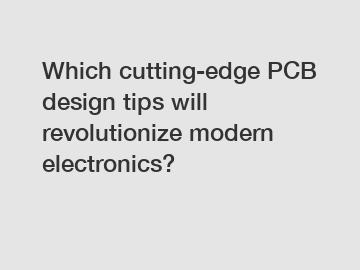Which cutting-edge PCB design tips will revolutionize modern electronics?
Which cutting-edge PCB design tips will revolutionize modern electronics?
PCB (Printed Circuit Board) design is a crucial aspect of modern electronics. As technology continues to develop at an astounding pace, it is essential for designers to stay ahead of the curve and adopt cutting-edge techniques that can revolutionize the industry. In this article, we will explore some of the most promising PCB design tips that are poised to revolutionize the world of modern electronics.
1. Miniaturization: One of the most significant trends in the electronics industry is the demand for smaller, more compact devices. With each passing year, consumers expect devices that are not only powerful but also slim and lightweight. PCB designers are now focusing on miniaturization techniques that allow for more components to be packed in a smaller space. By using smaller and more efficient components, it is possible to create revolutionary electronics that offer enhanced functionality despite their reduced size.

2. Flexibility: Flexible electronics have gained significant attention in recent years due to their ability to conform to various shapes and surfaces. PCB designers are now integrating flexible materials into their designs, enabling electronics to be more versatile and adaptable. These advancements allow for the creation of curved displays, wearable devices, and even smart clothing. By utilizing flexible PCB designs, the possibilities for innovation in modern electronics expand exponentially.
3. High-Speed Design: With an increasing demand for faster and more reliable electronics, high-speed design techniques have become paramount. PCB designers are now focusing on minimizing signal loss, reducing cross-talk, and optimizing impedance matching to ensure the integrity of high-speed signals. Advanced routing algorithms and meticulous trace planning allow for improved signal reliability and reduced latency. By implementing cutting-edge high-speed design tips, modern electronics can achieve unmatched performance and speed.
4. Smart Integration: The rise of the Internet of Things (IoT) has opened up a new realm of possibilities for interconnected devices. PCB designers are now embracing the concept of smart integration, where multiple functionalities are seamlessly integrated into a single PCB design. This integration eliminates the need for multiple individual circuit boards, reducing the size and cost of electronic devices. By incorporating sensors, connectivity modules, and microcontrollers into a single PCB, designers can revolutionize modern electronics by enabling them to interact with the world around them.
5. Power Optimization: As consumers demand longer battery life and energy-efficient devices, power optimization has become a critical consideration in PCB design. Designers are employing techniques such as power gating, clock gating, and voltage scaling to reduce power consumption without compromising performance. By carefully managing power distribution and incorporating low-power components, modern electronics can become more sustainable and user-friendly.
6. Advanced Thermal Management: The increasing power densities in modern electronics demand effective thermal management to prevent overheating and ensure the longevity of electronic components. Advanced techniques, such as incorporating heat sinks, thermal vias, and a balanced copper distribution, enable efficient heat dissipation. By focusing on effective thermal management, PCB designers can enhance the reliability and durability of modern electronics.
In conclusion, the world of modern electronics is on the cusp of a revolution, thanks to cutting-edge PCB design tips. From miniaturization and flexibility to high-speed design and smart integration, these techniques are pushing the boundaries of what is possible in the world of electronics. Power optimization and advanced thermal management are also crucial considerations that pave the way for more sustainable and efficient devices. By adopting these innovative approaches, PCB designers can drive the future of modern electronics, leading to a world of smaller, more versatile, and highly functional devices. So, what are you waiting for? Start exploring these cutting-edge techniques and be a part of the revolution in modern electronics!
For more information, please visit mintecelec.com, mintecelec.com, Mintec Electronics.


